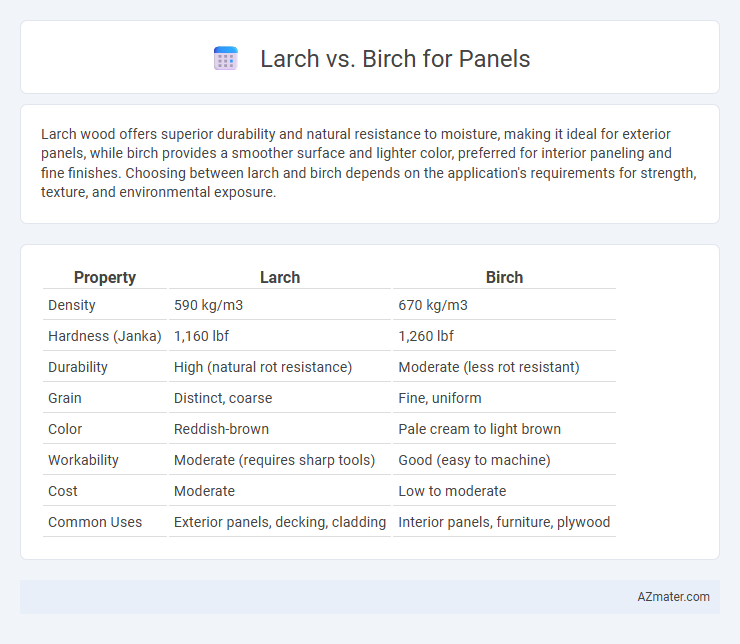Larch wood offers superior durability and natural resistance to moisture, making it ideal for exterior panels, while birch provides a smoother surface and lighter color, preferred for interior paneling and fine finishes. Choosing between larch and birch depends on the application's requirements for strength, texture, and environmental exposure.
Table of Comparison
| Property | Larch | Birch |
|---|---|---|
| Density | 590 kg/m3 | 670 kg/m3 |
| Hardness (Janka) | 1,160 lbf | 1,260 lbf |
| Durability | High (natural rot resistance) | Moderate (less rot resistant) |
| Grain | Distinct, coarse | Fine, uniform |
| Color | Reddish-brown | Pale cream to light brown |
| Workability | Moderate (requires sharp tools) | Good (easy to machine) |
| Cost | Moderate | Low to moderate |
| Common Uses | Exterior panels, decking, cladding | Interior panels, furniture, plywood |
Introduction to Larch and Birch Wood
Larch wood, known for its durability and rich reddish color, is prized in panel construction for its natural resistance to rot and moisture, making it ideal for both interior and exterior applications. Birch wood offers a fine grain and pale hue, providing a smooth finish and strength that suits decorative paneling and furniture. Both woods exhibit excellent workability and stability, with larch favored for outdoor resilience and birch preferred for aesthetic appeal in indoor environments.
Botanical Origins and Growth Habits
Larch (Larix spp.) is a deciduous conifer native to cooler regions of the Northern Hemisphere, known for its needle-like leaves that turn golden before shedding annually, while Birch (Betula spp.) is a deciduous hardwood found primarily in temperate and boreal zones, characterized by its distinct white or silver bark and serrated leaves. Larch trees grow rapidly and thrive in well-drained, acidic soils, often used for durable paneling in outdoor applications due to its natural resin content and rot resistance. Birch exhibits moderate growth rates, prefers moist, well-drained soils, and is prized for its fine grain and pale color in interior panel products, offering strength and an attractive finish.
Appearance and Grain Patterns
Larch wood features a warm reddish-brown hue with pronounced, straight grain patterns that create a visually striking panel surface. Birch offers a lighter, creamy color with fine, even grain, providing a smooth and subtle texture ideal for modern, clean-lined designs. Both woods display natural beauty, but Larch's bold grain contrasts sharply with Birch's uniform appearance, influencing the aesthetic choice for paneling projects.
Strength and Durability Comparison
Larch wood exhibits superior strength and durability compared to birch, making it an ideal choice for panels exposed to heavy use and outdoor conditions. Its natural resin content provides exceptional resistance to rot and insect damage, extending the lifespan of larch panels significantly beyond birch. Birch, while dense and hard, is more prone to moisture absorption and wear, limiting its durability in high-stress applications.
Moisture Resistance and Stability
Larch wood offers superior moisture resistance compared to birch, making it ideal for panel applications exposed to humid conditions. Its natural resin content enhances durability and reduces swelling, ensuring long-term dimensional stability. Birch panels, while smoother and more uniform, tend to absorb moisture more readily, which can lead to warping and decreased structural integrity in damp environments.
Workability and Ease of Finishing
Larch offers moderate workability with a slightly coarse texture that requires sharp tools for smooth cutting, while birch is known for its excellent workability, allowing for precise cuts and intricate detailing. When it comes to finishing, birch panels absorb stains and finishes evenly, producing a smooth, consistent surface ideal for fine furniture and cabinetry. Larch, due to its resin content, can be more challenging to finish but provides a durable, rustic appearance favored for exterior panels and heavy-use surfaces.
Cost and Availability
Larch wood generally offers a higher cost compared to birch due to its durability and resistance to moisture, making it a preferred choice for exterior and heavy-duty panels. Birch is widely available and more affordable, often favored for interior paneling and decorative purposes because of its fine grain and smooth finish. Availability of birch is more consistent globally, while larch supply can fluctuate depending on regional forestry practices and demand.
Common Applications for Panels
Larch panels are favored for exterior cladding and decking due to their natural durability and resistance to moisture, making them ideal for outdoor environments. Birch panels are commonly used in interior applications such as furniture, cabinetry, and wall paneling because of their smooth texture and fine grain, providing a high-quality finish. Both larch and birch offer excellent structural strength, but larch excels in weather resistance while birch is preferred for aesthetic appeal in indoor settings.
Environmental Impact and Sustainability
Larch wood offers a high natural durability and resistance to decay, reducing the need for chemical treatments and extending the lifespan of panels, which supports sustainable building practices. Birch, while less durable outdoors, is highly renewable due to its fast growth rate and ability to thrive in diverse climates, making it a sustainable choice when sourced responsibly from managed forests. Both woods provide eco-friendly options, but larch's longevity may result in a lower overall environmental impact over the product lifecycle compared to birch panels.
Choosing the Right Wood for Your Project
Larch wood offers exceptional durability and water resistance, making it ideal for exterior paneling where long-term weather exposure is a factor, while birch provides a smoother finish and lighter color, suited for interior panels requiring a polished aesthetic. Larch's dense grain structure enhances strength and natural rot resistance, whereas birch is easier to stain and paint, allowing for versatile design options. Selecting between larch and birch depends on project requirements such as exposure to elements, desired finish, and budget constraints.

Infographic: Larch vs Birch for Panel
 azmater.com
azmater.com